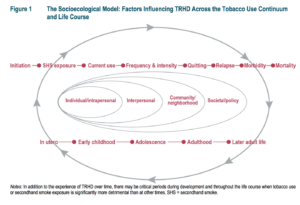
On September 12, 2017, National Cancer Institute (NCI) released Monograph 22: A Socioecological Approach to Addressing Tobacco-Related Health Disparities. Monograph 22 discusses the tobacco-related trends by identifiers such as age, race, and sexual orientation along with economic status as a means of discussing causes and potential solutions for tobacco-related health disparities (TRHD).
While there has been significant progress in reducing tobacco use, the reduction is not benefitting all groups of people at a similar rate, leading to higher rates of tobacco-related health problems and deaths for communities that have a lower reduction rate. Rates of tobacco use are higher among groups with lower incomes and levels of education, and groups that are targeted by tobacco industry advertising such as youth, African-Americans, and women. Read more about disparities at the point of sale here.
The major findings of Monograph 22 are as follows:
- While there has been significant progress in reducing tobacco use, the reduction is not benefitting all groups of people at a similar rate, leading to higher rates of tobacco-related health problems and deaths for communities that have a lower reduction rate.
- Many different factors in individual, interpersonal, community/neighborhood (which includes tobacco retailers and POS marketing), and societal/policy levels impact TRHD.
- Research shows that more widespread and accelerated implementation of effective strategies, such as Tobacco 21 or increased tax policies, would significantly reduce TRHD.
- More research is important and necessary to understand and solve TRHD.
- Better attention needs to be given to populations that are impacted by TRHD and the factors that contribute to them.
Monograph 22 is separated into 12 chapters which are further divided into four sections: Overview & Epidemiology, Intrapersonal/Individual Factors Associated with TRHD, Interpersonal & Contextual Factors That Contribute to TRHD, and Societal-Level Influences on Tobacco Use. The final section, chapters 10-12 (Societal-Level Influences on Tobacco Use), is most relevant to point of sale focused tobacco control and relevant policy.
How does POS marketing contribute to TRHD?
Tobacco marketing works – the more exposure youth have to tobacco marketing and promotion the more likely they are to smoke, but tobacco marketing does not look the same and is not present in the same quantity everywhere. It’s not that certain groups are more affected by the same tobacco marketing that everyone sees. It’s that the tobacco industry specifically targets certain groups with both advertising content and the amount of advertisements present in areas where those groups live. Its a double whammy – targeted ads, and more of them.
How can counter marketing campaigns help reduce TRHD?
Previous research shows that anti-tobacco TV youth-focused campaigns work overall at reducing tobacco use among the general population, but does not explicitly show a reduction by targeted group. However, anti-tobacco campaigns have more positive impacts on low-socioeconomic status and racially diverse youth when the campaigns are supplemented by facilitated anti-tobacco programming and activities. Similarly, adults from groups with high exposure to tobacco marketing also benefit from targeted anti-tobacco campaigns that trigger emotion, but are more likely to be impacted if the campaign also provides support via quitline, providing NRT, and community programming.
As media has changed, so has access. With the rise of the internet, the impact of online marketing also needs to be evaluated further, but the research that has been done demonstrates that ethnic minorities also receive more exposure to pro-tobacco marketing online. Institutional-level inequities, such as less access to healthy foods or health care and more access to tobacco retailers, have the potential to make TRHD worse, and as tobacco use becomes more prevalent among those with the least resources, it is important that anti-tobacco advocates know how to effectively communicate with these groups.
The Impact of Policy on TRHD
Tobacco control policies at federal, state, and local levels all have considerable potential to reduce TRHD. Evidence demonstrates that tax increase policy that leads to higher cost at the point of sale is the most effective at reducing youth and people of low-socioeconomic status smoking rates.
Research also shows that policies focused on age of sales (Tobacco 21) are effective in reducing youth smoking rates when the policy is well enforced. Smoke-free policies effectively lower non-smokers exposure to second hand smoke while decreasing smoking rates among youth and adults overall, but research demonstrates that people of color and low-income people are less likely to be impacted by smoke-free policies, because they are less likely to work within the venues that are covered by the policies.
Researchers completed a tobacco policy simulation called SimSmoke. This simulation helps researchers see the impacts of potential policies based on previous impact data. From this simulation, researchers were able to confirm for themselves that tax increase policies in tobacco control are the most effective policies in reducing TRHD, and have the highest impact on youth under the age of 18, who are most sensitive to cost. The monograph mentions that price increases are often combatted by price promotions that re-lower the cost. Though they were not mentioned, strong minimum price policies can help maintain price increases, resulting in positive impacts on price sensitive demographics, such as youth and low-income groups.[1]
While the monograph does not mention policies that impact retailer density, it has been demonstrated that restricting the sale of tobacco products near schools or near other tobacco retailers can effectively reduce access to tobacco and reduce the amount of exposure to POS marketing.
Link to both Executive Summary and Full Report


